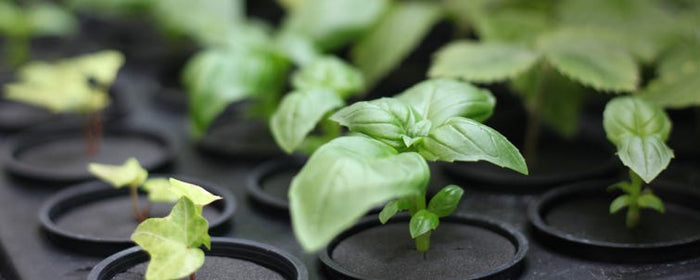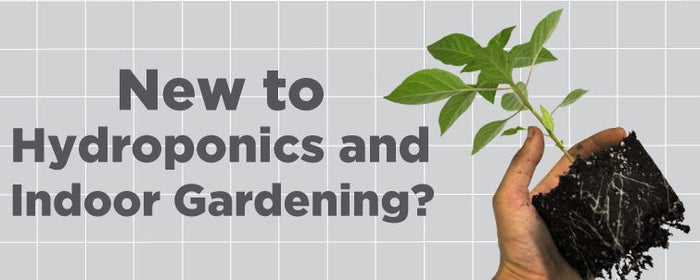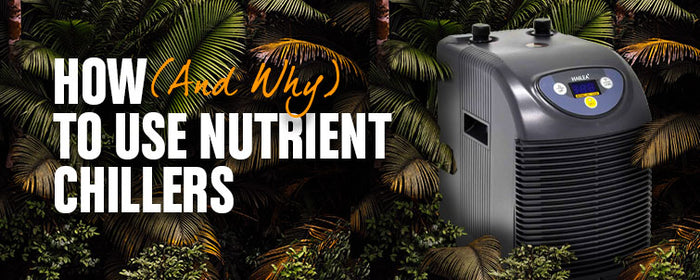![AutoPot – Save Time & Money [Q & A]](http://www.growell.co.uk/cdn/shop/articles/blogheader_autopotq_a.jpg?v=1673520420&width=1100)
AutoPot – Save Time & Money [Q & A]
Want to save time, energy and boost your yield? There’s only one system for it – an AutoPot System.
What are AutoPots? How do AutoPot systems work? Jason has joined us to talk us through his bestselling systems.
Q
What’s the AutoPot story?
A
AutoPot was first formed in April 2001. Initially we imported a similar product from Australia.
However, due to manufacturing issues and lack of supply, we decided to create our own designs while removing all the flaws from the older concept.
Q
Interesting, so what makes the AutoPot unique?

A
For a long time, I had been looking at creating a simple-to-use irrigation system. One that would allow even the most novice gardeners to get a result.
I decided to let plants control their own nutritional needs - all without the use of power.
At the same time, the system would need to be extremely versatile and modular, with the ability to save huge amounts of water and fertiliser.
As gravity is always free, we created the AQUAvalve. Plants control the AQUAvalve, the AQUAvalve controls the flow of water.
Q
Genius. Can you tell us a bit more about how the AQUAvalve and AutoPot System works?



A
To save power and keep systems silent, no pumps are needed to deliver the nutrient enriched water to the plants.
To make this possible, we developed the patented AQUAvalve. It is probably the only effective technology that is completely controlled by plants.
Gravity pressure moves water from the reservoir, along the pipework to the trays/modules that sit under plants.
When the system is turned on, the AQUAvalve allows water to fill the module/ tray to a level of 20mm. It then shuts until all water has been consumed by plants.
After 30-60mins, the AQUAvalve will then re-open to allow another amount of water to enter the tray. This prevents nutrient waste and removes the need for a pump.
Q
Interesting. And how does this increase AutoPot yield?

A
I am a big believer of only supplying plants with what they need, when they need it.
Plants are in total control of their feeding requirements, with very little human intervention. At AutoPot, we call this technology PCI or Plant Controlled Irrigation.
The hotter the day or the bigger the plants, the greater their feeding needs. This affects how often the AQUAvalve opens and closes.
With unrestricted access to water and nutrients, you get huge yield increases.
Q
This also helps prevent nutrient waste, right?
A
Correct! All the water delivered to plants must be completely consumed before another consignment is delivered.
No water is ever wasted or disposed of. This makes the AutoPot one of the most environmentally conscious irrigation systems presently available worldwide.
Water and nutrient savings have been recorded at up to 45% compared to all other irrigation technologies, saving the grower time and money.
Q
Awesome stuff. So how do you stop feed stagnating?

A
Every time an AQUAvalve opens and water is delivered from the reservoir, there is natural water movement. Water becomes agitated and aerated as it injects through the AQUAvalve nozzle and into the tray. So stagnation isn’t really an issue.
A water pump can be used in the reservoir to gently move the water around, but is not necessary if a good quality mineral fertiliser is being used.
Never use an air stone! The pH of your feed can be increased. Besides, no air is actually being added to the water as all the air bubbles break on the water’s surface.
Generally, only organic feeds will become stagnant if left in a reservoir due to the organic nature of their composition, so we wouldn’t recommend using these.
Q
So what nutrients would you recommend using?
A
We would strongly recommend a good, clean mineral fertiliser – there are many suitable brands.
Please refrain from adding anything with organic ingredients. These can separate and cause blockages. To check if a nutrient could cause blockages, leave a teaspoon of the nutrient in a glass of water overnight or up to a week with some viscous nutrients. If they start to separate, avoid using them.
If any viscous (gooey) additives are used, they should be applied as follows:
- Turn off the reservoir tap 12 hours before applying the additive.
- 12 hours later, pour a controlled amount directly into each tray module (not through the pot) up to the pipe inlet point.
- Leave for 30mins, then top up all the trays in the same manner
- 12 hours later, turn the reservoir back on.
By following this simple procedure, any form of additive or booster can be used. We would suggest following these guidelines every 5-7 days if required.
Q
All good advice. In some growing systems, roots can grow into the pipework. How do you prevent this in an AutoPot?


A
Roots are deceptively strong and invasive. Many years ago, I designed a concept that utilises a fabric that is impregnated with a copper coating. We now provide Root Control Discs, that are placed inside the pot or are placed under the pot.
We also supply Pot Socks that fit on the bottom outside of the pot. These concepts are designed to keep the roots in the pot, where you want them.
However, please always check the AQUAvalve area from time to time. If any roots do manage to escape the pot, they can be easily cut away with a pair of scissors without any detrimental damage to the root system or plant. At the end of the day, roots can navigate through concrete, so it’s always prudent to check the AQUAvalve from time to time.
Q
Simple enough. So how easy would you say AutoPots are to use?

A
Apart from a watering can, I can safely say that an AutoPot is probably one of the simplest systems to set up and operate.
You just fill the reservoir with water, add a suitable fertiliser and adjust the pH if it’s required. All that’s left is to turn on the reservoir tap and that’s it. As long as water is in the system, it’ll operate 24hours a day, 365 days a year.
The system is completely modular, and modules of any design can be added at any time. There is no fixed layout, as the modules can be positioned anywhere the grower wishes to place them.
Q
What growing media can customers use in an AutoPot?

A
Over the years, there have been many strange and varied media mixes used in our systems. Washed, crushed old coral from the beaches of Thailand; rice husks; cotton; pumice stone; glass to name just a few.
However, the rule of thumb is as follows:
Choose a substrate or blend of substrates that provides good capillary action.
Clay pebbles alone provide very little capillary action, but Perlite does.
You want a blend that provides good air retention within the pot and a good structure.
To test, take an amount of substrate in your hand, squeeze it and then see how it falls apart in your hand when you touch it.
For example, if you squeezed clay, it would not fall apart, and no air would be held within the clay. This wouldn’t be suitable. Some of the most popular growing media mixes contain coco & clay pebbles or soil & perlite. As longs as you follow the basic principles above, you have many options to choose from.
I would, however, stress to keep it simple in the early part of your growing life and then trial once you have created a nice blueprint of success.
Q
Can you please explain how to flush AutoPot Systems?
A
Don’t forget to flush your system lines. To do this, drain of 1 – 2 litres of nutrient solution every 2 weeks by turning on the taps found at the end of your 16mm or 6mm pipe.
Q
How often would you recommend filling AutoPot reservoirs?
A
Always refill your reservoir when there is a 1/3 of the solution left. Never let it run empty.
Q
And how do you mix AutoPot Nutrients?

A
- Before refilling, turn off the tap at the bottom.
- Fill up, add fertiliser and mixed up.
- 30 minutes later, turn the tap back on.
This will allow any sediment in the bottom of the reservoir to settle below the tap line, which naturally forms over time.
ALWAYS remember to turn the tap back on after 30mins.
Whenever pouring water into a pot, always use warm water. Never use cold water... it will shock plants.
In soil, feed with warm water (pH 5.8).
In coco or rockwool, feed them a weak nutrient solution (pH of 5.6).
Q
What Size AutoPot System would you recommend using?
A lot of customers ask how to size up an autopot system. Generally we would recommend these sizes:
A
| Minimum | Recommended | |
| 4 Pot | 100cm x 100cm | 120cm x 120cm |
| 8 Pot | 150cm x 150cm | 120cm x 240cm |
| 12 Pot | 120cm x 240cm | 200cm x 200cm |
| 16 Pot | 200cm x 200cm | 240cm x 240cm |
| 24 Pot | 240cm x 240cm | 240cm x 360cm |
| 36 Pot | 200cm x 300cm | 360cm x 360cm |
| 48 Pot | 240cm x 360cm | 360cm x 600cm |
| 60 Pot | 360cm x 600cm | 500cm x 800cm |
| 72 Pot | 480cm x 500cm | 600cm x 700cm |
| 80 Pot | 600cm x 480cm | 800cm x 700cm |
| 100 Pot | 600cm x 600cm | 800cm x 800cm |



Q
How big can you go with an AutoPot system?
A
There’s no limit, due to how the water and nutrients are delivered. As gravity is always free and available, we are not held back.
You can expand your existing AutoPot systems. As you scale up, you will eventually need to upgrade your tank. And when your pot count is greater than six, we recommend that you start using 16mm pipe as the main supply pipe from larger reservoirs. The pipe is then simply reduced to 6mm pipe at each AQUAvalve connection.
For large commercial nurseries, we generally use anywhere between 1,000 -20,000 litre reservoirs, raised several meters above the ground. A float switch (ball cock) is connected in the upper part of the reservoir. This maintains a full head of water and a constant water pressure below.
The reservoirs are frequently connected to solar dosing units that simply mix nutrients with water and pump it into the supply reservoir. It makes using the system very simple and user friendly.
Q
Hardly surprising that you’ve got a lot of commercial clients then...

A
Not at all. They have a number of benefits.
To begin with, AutoPots are very labour saving. This makes very popular with commercial growers.
A client in Nevada runs 9,000 1Pot XL modules. Prior to installation, they had anticipated that 40 staff members would be needed to help run the operation. In reality, they only need 9 people.
Over the years, AutoPot technology has reached most places on earth. Some of the clients we have supplied to have been in very unusual places, as far north as you can go or grow.
We’ve supplied to a 5 hectare island in the Maldives that has been leased for 50 years. The middle vegetation was cleared, and greenhouses installed, to grow rock melons for the hotels on the other islands.
Q
Impressive. We hear that a lot of your clients are off grid, too.

A
They are. If you’re off the grid and there’s no stable power source, AutoPot is really the only viable option.
The environmental issues associated with the technology are a huge plus. Water and fertiliser are never lost or wasted. Since water never recirculates, diseases will never pass from one plant to another.
Q
And what’s the biggest set up you’ve seen?
A
There have been some extremely large commercial nurseries over the years.
In Bangkok, we set up a commercial nursery that was around 1 acre. This site was unique as the system was connected to an Aquaponics facility. The fish waste was filtered and delivered to the AutoPot reservoirs.
Everything was totally organic, with the fish and the produce being sold to the largest hospital in Bangkok.
We have some extremely large projects running in the UAE growing a huge variety of produce.
Here in the UK, we are currently setting up a commercial nursery that will produce “cut and come again” Thai Sweet Basil. By the time the facility is fully up and running we will have over 70,000 pots all irrigated using our technology.
Well that’s all of our questions. Thanks for joining us today. A lot of our growers love these systems so we’ll no doubt work together in future to produce more guides and brochures.






